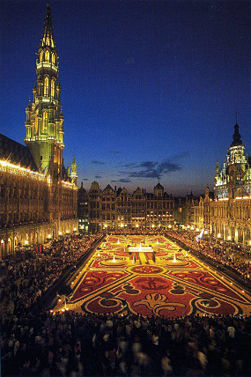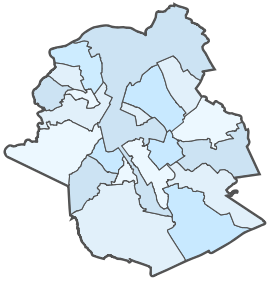Grand Place
| Grand-Place, Brussels* | |
|---|---|
| UNESCO World Heritage Site | |
 |
|
| The place at night with the flower carpet; Town Hall to the left.
|
|
| State Party | |
| Type | Cultural |
| Criteria | ii, iv |
| Reference | 857 |
| Region** | Europe and North America |
| Inscription history | |
| Inscription | 1998 (22nd Session) |
| * Name as inscribed on World Heritage List. ** Region as classified by UNESCO. |
|
The Grote Markt (Dutch) or Grand Place (French) is the central market square of Brussels. It is surrounded by guild houses, the city's Town Hall and the Bread House (Dutch: Broodhuis, French: Maison du Roi). The square is the most important tourist destination and most memorable landmark in Brussels next to the Atomium and Manneken Pis.
Contents |
History
The Town Hall was constructed between 1402 and 1455. The original architect was probably Jacob van Thienen. The gothic tower was designed by architect Jan van Ruysbroeck. At the top of the 97 meter (318 feet) tower stands a statue of St. Michael, the patron of Brussels.
In the 13th century the predecessor of the Bread House was a wooden building where bakers sold their bread in a covered market. Its Dutch name Broodhuis recalls this function. It was replaced in the 15th century by a stone building for the administration of the duke of Brabant. When the duchy fell to the Habsburgs, the Maison du Duc (Duke's house) became the Maison du Roi (King's house), the latter being the current French name of the building. Charles V rebuilt the building in a late Gothic style during his reign in the 16th century, similar to its appearance today. In 1873, the city entrusted architect Victor Jamaer to restore the battered structure in neo-gothic style.

The Grand Place was first laid out after the construction of the town hall, at the centre of the city's commercial district. Neighboring streets still reflect the area's origins, named after the sellers of butter, cheese, herring, coal and so on. The original Grand Place was a medley of buildings constructed between the 15th and 17th centuries in a variety of styles.
On August 13, 1695, a 70,000-strong French army under Marshal François de Neufville, Duke of Villeroy began a bombardment of Brussels in an effort to draw the League of Augsburg's forces away from their siege on French-held Namur in what is now southern Belgium. The French launched a massive bombardment of the mostly defenseless city centre with cannons and mortars, setting it on fire and flattening the majority of the Grand Place and the surrounding city. Only the stone shell of the town hall and a few fragments of other buildings remained standing. That the town hall survived at all is ironic, as it was the principal target of the artillery fire.
The square was rebuilt in the following four years by the city's guilds. Their efforts were regulated by the city councilors and the Governor of Brussels, who required that their plans be submitted to the authorities for their approval. This helped to deliver a remarkably harmonious layout for the rebuilt Grand Place, despite the ostensibly clashing combination of Gothic, Baroque and Louis XIV styles.
The Grand Place was named by UNESCO as a World Heritage Site in 1998. One of the houses was owned by the brewers' guild, and is now the home of a brewers' museum.
Flower carpet
The Grand Place is well known for its large "flower carpet". This display of begonias is arranged on the square every two years for a few days in the middle of August, and attracts many tourists.[1]
In popular culture
- The square is a pilgrimage site for fans of the cult BBC television series Secret Army, the second and third series of which were filmed here in 1978 and 1979, specifically around the building that is now Maxim's restaurant.
References
- ↑ "Tourist Attractions in Brussels". trabel.com. Retrieved on 2008-06-04.
External links
- Panorama 360° of "Grand Place from Brussels"
- UNESCO page related to the Grand Place
- Virtual visit, photos and webcam of the Grand Place
- The Maison-du-Roi or Broodhuis
- Brussels' Flowercarpet Official site of the flower carpet
|
|||||||
|
||||||||||||||||||||||||||||||||||||||||||

